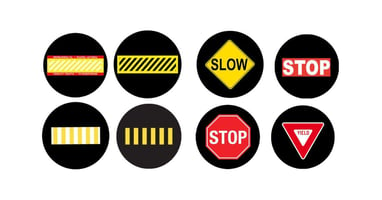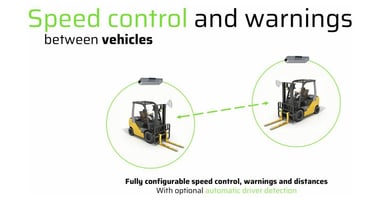When it comes to running a successful warehouse, smooth operations and safety go hand in hand....
How Overhead Crane Safety Lights Reduce Accidents and Improve Worker Safety


In the heart of industrial world, where metal clashes, engines roar, and the movement of goods sets the rhythm of progress, the safety of those at work is paramount. Transportation, metalworks, oil refineries, automobile manufacturing, shipping, and storage operations—all these sectors rely heavily on the might of overhead cranes. Yet, with great power comes great responsibility, particularly in ensuring the safety of workers navigating these Herculean machines. Enter the a smart tool of safety in this complex dance of machinery: overhead crane safety lights.
Understanding Overhead Crane Safety Lights
At their core, overhead crane safety lights are not merely illuminative devices; they are guardians of the work floor. These lights project bright, visible beams onto the ground, outlining the path of the crane's movement or highlighting its current location. From spotlights that cast a focused beam to warning lights that blink in anticipation of movement, each variation serves a distinct purpose. The advent of LED technology and motion sensors has further catapulted these devices into the future, offering unparalleled brightness, longevity, and responsiveness.
The Role of Safety Lights in Preventing Workplace Accidents
Statistics paint a grim picture of accidents involving overhead cranes, often resulting in severe injuries or fatalities. But safety lights emerge as a key safety solution. Consider the transformation within a metalworks facility post-integration of LED path lights—incidents involving pedestrian collisions with moving cranes reduced to a statistical zero. These lights work by enhancing visibility, offering clear warning signals, and demarcating safe zones, thus significantly reducing the risk of accidents.

Compliance and Regulatory Considerations
Navigating the maze of safety regulations is a task familiar to safety directors. Adhering to standards set by bodies such as OSHA is not merely about compliance but about embodying a commitment to worker safety. Overhead crane safety lights play a pivotal role in this endeavor, helping facilities meet stringent safety requirements and fostering an environment where safety is woven into the very fabric of operations.
Implementation Strategies for Overhead Crane Safety Lights
For safety directors embarking on the journey of implementing safety lights, the path involves several key steps:
- Assessment: Evaluating the specific needs of your operation to determine the most suitable types of safety lights.
- Selection: Choosing lights that offer the best visibility, durability, and compliance with regulatory standards.
- Integration: Seamlessly incorporating safety lights into existing safety protocols and machinery operations.
- Training: Educating workers on the new safety features and how to respond to the signals provided by safety lights.
By following these steps, safety directors can ensure a smooth transition to a safer workplace, enhanced by the vigilant presence of safety lights.
Beyond Safety Lights: A Comprehensive Approach to Overhead Crane Safety
While safety lights are a significant leap forward in preventing accidents, they are but one piece of the puzzle. A holistic approach to safety encompasses regular maintenance checks, comprehensive safety training programs, and the cultivation of a safety-first culture within the organization. Technologies such as crane operation simulations further augment this ecosystem, offering workers the chance to hone their skills in a risk-free environment.
Conclusion
In industrial operations, where every move counts and the stakes are high, the introduction of overhead crane safety lights stands out as a critical step toward safeguarding the well-being of workers. These devices offer more than just illumination; they serve as a constant reminder of the importance of safety in the workplace. For safety directors at the helm of these initiatives, the message is clear: integrating overhead crane safety lights is not just a regulatory obligation but a moral imperative, a testament to the value placed on human life and well-being.
As we look toward the future, let us light the way with safety, vigilance, and a steadfast commitment to preventing accidents before they happen. The adoption of overhead crane safety lights is a shining example of this commitment, guiding us toward a safer, more secure industrial landscape.
Key Takeaways
- Crucial Role of Safety Lights: Overhead crane safety lights are indispensable in enhancing workplace safety by illuminating paths, signaling crane movements, and demarcating safe zones.
- Variety and Technology: A range of safety lights, including spotlights and warning lights equipped with advanced features like LED technology and motion sensors, cater to diverse industrial needs.
- Accident Prevention: Implementing safety lights has been proven to significantly reduce accidents involving overhead cranes by increasing visibility and providing clear warnings to workers.
- Regulatory Compliance: Safety lights not only bolster safety measures but also aid in adhering to OSHA standards and regulations, ensuring a safer and compliant workplace.
- Holistic Safety Approach: While safety lights are pivotal, a comprehensive approach incorporating regular maintenance, safety training, and a culture of safety is essential for maximum protection.
- Strategic Implementation: Effective implementation of safety lights involves assessing needs, selecting appropriate technologies, integrating them into existing safety protocols, and training workers on their importance and use.

FAQs
Are overhead crane safety lights mandatory by law?
While not all jurisdictions explicitly mandate the use of safety lights on overhead cranes, many OSHA guidelines and workplace safety standards strongly recommend their use as part of general safety practices to prevent accidents and ensure a safe working environment.
What types of overhead crane safety lights are most effective?
The effectiveness of safety lights depends on the specific operations and environment. Generally, LED spotlights that project a clear path and warning lights that signal crane movements are highly effective. The choice between them should be based on the layout of the workplace and the type of crane operations conducted.
Can the installation of safety lights disrupt existing operations?
Installation is usually straightforward and can be conducted with minimal disruption. Planning the installation during downtime and providing proper training can mitigate any temporary disruptions, ensuring a smooth transition to safer operations.
How often do safety lights need to be replaced or maintained?
LED safety lights are known for their longevity and require minimal maintenance. However, regular checks are recommended to ensure they are functioning correctly and to replace any units that are damaged or have significantly diminished in brightness.
How do safety lights improve compliance with safety regulations?
Safety lights enhance visibility and warn of potential hazards, directly addressing several regulatory requirements related to workplace safety. Their use demonstrates a commitment to maintaining a safe work environment, often going beyond the minimum legal requirements and potentially reducing the risk of non-compliance penalties.
Can safety lights be customized for different industrial environments?
Absolutely. Safety lights come in various types and configurations, allowing for customization based on the specific needs of different industrial environments. Factors like beam width, color, and brightness can be tailored to meet the unique requirements of each workplace.
Safety directors, the decision is in your hands. Illuminate your operations with LED lighting and set a new standard for safety and efficiency in your industry. The future is bright, and it's lit by LEDs. Book a consultation meeting today, and we'll get started on integrating these important devices into your operations.




